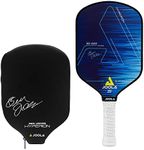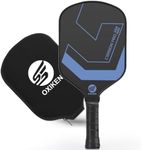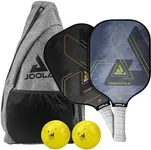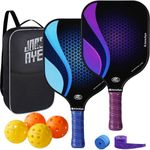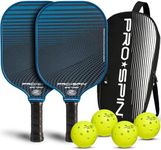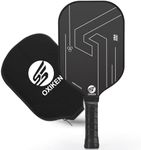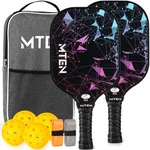Buying Guide for the Best Pickleball Paddles
Choosing the right pickleball paddle can make a big difference in your enjoyment and performance on the court. The best paddle for you depends on your playing style, skill level, and physical comfort. It's important to understand the main features of paddles so you can match them to your needs, whether you're a beginner looking for control or an experienced player seeking power. By learning about the key specs, you can make a confident choice that helps you play your best.WeightWeight refers to how heavy the paddle feels in your hand and is usually measured in ounces. This is important because it affects both your power and control. Lighter paddles (around 7 ounces or less) are easier to maneuver and are good for quick reactions and control, making them suitable for players who like to play at the net or have arm or wrist concerns. Medium-weight paddles (about 7.3 to 8.4 ounces) offer a balance between power and control, making them a popular choice for most players. Heavier paddles (over 8.5 ounces) provide more power with less effort but can be harder to control and may cause fatigue over long games. To pick the right weight, consider your strength, playing style, and whether you prioritize quick movements or powerful shots.
Grip SizeGrip size is the circumference of the handle and is important for comfort and control. A grip that is too large or too small can lead to discomfort or even injury. Smaller grips (around 4 inches) allow for more wrist action and control, which is helpful for players with smaller hands or those who like to add spin. Larger grips (up to 4.5 inches) offer more stability and are better for players with bigger hands or those who want a firmer hold. To choose the right grip size, measure your hand or try holding different paddles to see what feels most comfortable and secure.
Paddle Shape and SizePaddle shape and size refer to the overall dimensions of the paddle, including the length and width. Standard paddles are about 8 inches wide and 15-16 inches long, offering a good balance of reach and hitting area. Elongated paddles are longer and narrower, giving extra reach and power but a smaller sweet spot, which can be challenging for beginners. Widebody paddles have a larger hitting area, making them more forgiving and easier for new players. Your choice should depend on whether you want more reach and power or a larger, easier-to-hit surface.
Core MaterialThe core material is what’s inside the paddle and affects how the paddle feels and plays. Common core materials include polymer (plastic), aluminum, and Nomex (a type of hard paper). Polymer cores are the most popular because they are quiet, soft, and provide good control, making them suitable for most players. Aluminum cores are lightweight and offer good control but can feel less powerful. Nomex cores are harder and provide more power and a louder sound, which some advanced players prefer. Think about whether you want a softer feel and more control or a harder, more powerful hit when choosing the core material.
Surface MaterialSurface material is the outer layer of the paddle and affects spin, power, and durability. Common surfaces include graphite, fiberglass, and composite. Graphite surfaces are lightweight and provide a crisp, responsive feel, making them good for control and quick play. Fiberglass surfaces are slightly heavier and offer more power and a larger sweet spot, which can help with consistent shots. Composite surfaces combine different materials for a balance of power and control. Consider whether you want more control or more power, and how much spin you like to put on the ball, when picking the surface material.

